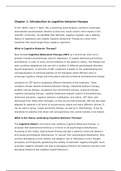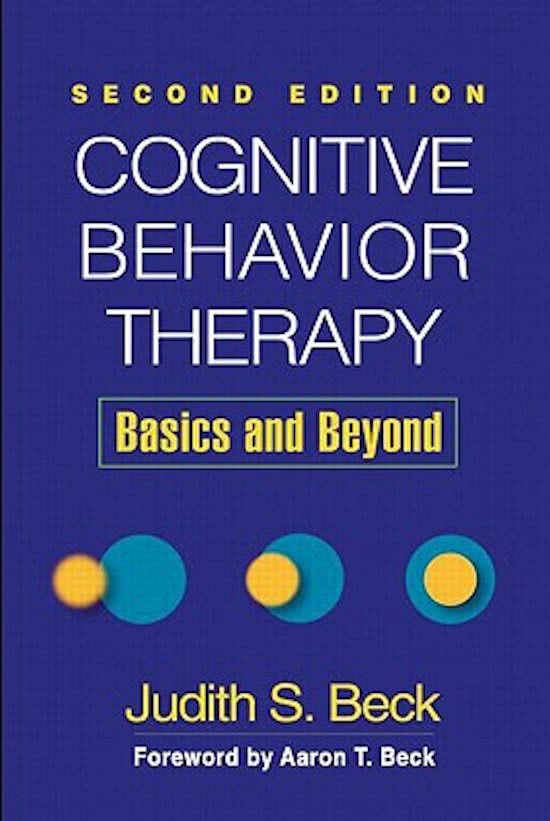Chapter 1: Introduction to cognitive behavior therapy
In the 1960’s, Aaron T. Beck, MD, a practicing psychoanalyst, wanted to empirically
demonstrate psychoanalytic theories so that they would receive more respect in the
scientific community. He identified that distorted, negative cognition was a defining
feature of depression and created Cognitive Behavioral Therapy as a short-term
treatment that would target those negative cognitions.
What is Cognitive Behavior Therapy?
Beck devised Cognitive Behavioral Therapy (CBT) as a structured, short-term,
present-oriented psychotherapy used for depression. It targets dysfunctional thinking
and behavior in order to solve current problems in the patient’s coping. The therapy has
seen countless adaptations and use with a number of different psychological disorders
beyond depression. In all forms of CBT, treatment is based on the understanding and
conceptualization of individual patients as the therapists seeks different ways to
encourage cognitive change and bring about enduring emotional and behavioral change.
Variations on CBT tend to emphasize different elements of the treatment. These
variations include rational emotional behavior therapy, dialectical behavior therapy,
problem-solving therapy, acceptance and commitment therapy, exposure therapy,
cognitive processing therapy, cognitive behavioral analysis system of psychotherapy,
behavioral activation, cognitive behavior modification, and others. CBT often uses
techniques from these other therapies, so they are all interconnected. CBT has also been
adapted for patients in all levels of socioeconomic status and many different cultures. It
can be used in group, couple and family therapy, as well as in child therapy. It can be
shortened for patients (like those with schizophrenia) who cannot tolerate a full session.
What is the theory underlying Cognitive Behavior Therapy?
The Cognitive Model is the theory that underlies Cognitive Behavioral therapy. It
proposes that dysfunctional thinking is common to all psychological disturbances.
According to this model, dysfunctional thinking disrupts a patient’s mood and behavior
and causes psychological disturbances. To recover from psychological disturbance, then,
involves developing a more realistic and adaptive way of reflecting on one’s thought
processes, and frequently questioning the validity of automatic negative thoughts. Such
automatic negative thoughts can lead to damaging emotions like sadness (emotion) and
damaging behaviors like isolating oneself (behavior).
,In order to treat patients in a meaningful and lasting way, CBT therapists will focus on a
deeper level of cognition: a patient’s fundamental beliefs about themselves, their world,
and other people. If a person has an underlying belief that they are incompetent, this
may manifest you frequently underestimating your abilities and feeling powerless.
Combatting this belief would involve focusing on specific situations in which it is proven
false, and would allow one to see that having difficulty with certain tasks does not make
one universally incompetent.
What does the research say?
There is overwhelming support (more than 500 outcome studies) for the effectivity of
CBT as a therapy for depression and other psychological disorders. Several researchers
have found that there are neurobiological changes associated with CBT. Have a look al
table 1.1 on page 4.
How was Beck’s cognitive behavior therapy developed?
One of the main concepts of psychoanalysis is that depression is the result of hostility
turned inward toward the self. After some research, Beck found instead that depressed
people have more feelings of defectiveness, deprivation, and loss. He observed patients
having two streams of thoughts – automatic negative thoughts and evaluative thoughts
closely tied to emotions. When Beck helped patients identify, evaluate, and respond to
these unrealistic thoughts, they rapidly improved. Beck taught his residents to use the
treatment, and eventually worked together with A. John Rush on an outcome trial in
1977. This trial established that CBT was at least as effective as a common
antidepressant used at the time.
CBT helps patients identify and solve problems, activates their behaviors, and helps curb
depressed thinking and beliefs. Patients with anxiety not only need to learn to better
assess risks, they also need to decrease avoidance and confront scary situations.
What are the basis principles of treatment?
While CBT must be tailored to the individual patients, there are certain underlying
principles that persist through all effective CBT treatments.
1. CBT is based on an ever-evolving formulation of a patients’ problems and
an individual conceptualization of each patient in cognitive terms
Current thinking is identified to see where feelings of sadness originate. Problematic
behavior is identified, as well as any precipitating factors that may have influenced
,perceptions at the beginning of the depression. A hypothesis is made about how
developmental events may have caused enduring patterns of interpretation to occur and
to predispose the patient to depression. Once the patient is taught how to recognize
destructive thoughts, they are taught to formulate more adaptive cognitions.
A. Identify the current thinking that contributes to the feelings and the problematic
behaviors
B. Identify precipitating factors that influenced the perceptions
C. Hypothesize about key developmental events and the enduring patterns of interpreting these
events that may predispose the problem
2. CBT requires a sound therapeutic alliance
Therapists working with CBT must form an alliance with their patients, sharing a trusting
relationship and regarding the patient with care and warmth. Warmth, empathy, caring,
genuine regard and competence.
3. CBT emphasizes collaboration and active participation
CBT encourages the patient to see the therapy as teamwork – the therapist and patient
decide together what sort of work needs to be done, and how to do it.
4. CBT is goal-oriented and problem-focused
CBT involves working towards specific goals that are decided upon in the initial sessions.
Thoughts that interfere with that goal can be more easily identified and interrupted.
5. CBT initially emphasizes the present
Whereas some therapies emphasize the origin of issues (the past), CBT is all about the
present, regardless of the diagnosis. CBT only looks at the past in order to provide a
context to explain the childhood roots of dysfunctional thinking, or because the patient
expresses a strong desire to focus on the past.
6. CBT is educative, aims to teach the patient to be her own therapist, and
emphasizes relapse prevention
Educating the client is an essential element of CBT. Not only does the therapist explain
how automatic negative thoughts impact behavior, but they also help the client set goals,
identify and evaluate thoughts, and plan behavioral change. Therapy notes are taken
home so that the client may benefit longer from their treatment.
, 7. CBT aims to be time-limited
Depression and anxiety disorders tend to receive a treatment of six to 14 sessions, with
the goal of relieving symptoms, training positive coping methods, and helping patients
solve their most pressing problems. Some patients are easily treated in a short amount
of time, though others with more rigid beliefs may need a couple of years of attention.
8. CBT sessions are structured
A session of CBT follows a certain structure designed to maximize the efficiency and
effectiveness of the treatment. This involves an introduction (a mood check, a weekly
review, etc.), a middle (homework review, problem discussion, etc.), and a conclusion
(homework assignment, feedback).
9. CBT teaches patients to identify, evaluate, and respond to their
dysfunctional thoughts and beliefs
Therapists help patients identify the key cognitions that lead to their anxiety and to
adopt more realistic, adaptive cognitions that will lead them to feel better and tackle
issues more effectively.
Therapists do so through the process of guided discovery, using questioning to evaluate
their thinking. Therapists also create experiences, called behavioral experiments, for
patients to directly test their thinking. In these ways, therapists engage in collaborative
empiricism.
10. CBT uses a variety of techniques to change thinking, mood, and behavior
Strategies like Socratic questioning and guided discovery are only some among many
techniques used in CBT. Problem-solving and behavioral techniques are also essential.
Psychodynamic techniques can help as well. It is a case-by-case decision. The emphasis
in treatment also depends o the patient’s particular disorder(s).
What is a therapy session like?
At the beginning of sessions, you will reestablish the therapeutic alliance, check on
patients’ mood, symptoms, and experiences in the past week and ask then to name the
problems they most want help in solving. Also review the self-help activities. Then, you
will collect data about the problem, cognitively conceptualize patients’ difficulties and
collaboratively plan a strategy. As a specific problem is discussed, the cognitive
processes involved in the problem are brought up and can be picked apart. A strategy for
solving the problem is then collaborated upon. New homework is assigned.






